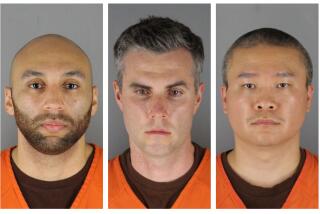Lung Surgery Benefits Some With Emphysema, Study Shows
- Share via
A landmark clinical trial has demonstrated the benefit of a controversial lung surgery, offering a potential treatment for some of those most severely afflicted with emphysema.
Medicare stopped paying for the $35,000 surgery, called lung volume reduction, in 1996, ruling that it was still experimental and that its benefits had not been proven. But program administrators agreed to fund a clinical trial, the first time Medicare has ever sponsored such a study.
Now, the five-year trial has shown that the surgery dramatically improves the quality of life for many of the 200,000 Americans with the most severe form of emphysema, allowing them to breathe more easily and carry out many daily activities. The study also showed which patients were most likely to benefit from the surgery and which were at greatest risk.
Lung volume reduction surgery “will likely be remade in the context of this trial and come back stronger than ever,” Dr. Keith Naunheim of St. Louis University said during a news conference at a Seattle meeting of the American Thoracic Society, where the results were unveiled. The findings will also be published this week in the New England Journal of Medicine.
“This surgery improves patients’ quality of life, which we believe is the most meaningful outcome for people with severe emphysema,” said Dr. Joel Cooper of the Washington University School of Medicine in St. Louis, one of the pioneers in development of the procedure. “In addition, the study confirms our more limited evidence that it may add to life expectancy.”
Medicare officials are expected to make a decision in the next month, based largely on the new findings, about whether to cover the procedure. Currently, there is no other effective therapy for the disease. If just 1% of emphysema patients submit to the procedure, experts said, it could add at least $300 million a year to the national health bill. Virtually all severe emphysema patients are over age 65, meaning that Medicare covers the bulk of their health costs.
Emphysema, which afflicts 2 million Americans, kills or contributes to the death of 100,000 each year. Although some emphysema is genetic, 80% of cases are the result of a lifetime of smoking. Chemicals, gases and tar in cigarette smoke cause the lung to literally dissolve. The tiny, pliable air sacs called alveoli, which normally expand and contract, break down and collapse into larger sacs that lose most of their elasticity.
The lungs gradually expand until they fill the entire chest cavity, pressing down on the diaphragm so that it can no longer regulate breathing. Muscles in the rib cage and abdomen take over, but breathing with them is inefficient and tiring.
In the 1950s, Dr. Otto Brantigan of the University of Maryland developed a procedure in which a quarter to a third of lung tissue was removed, allowing the remaining tissue to expand and contract more easily. He reported good results with some patients, but one in five died and the procedure slipped into disuse.
In the early 1990s, Cooper and others used more modern surgical techniques, including minimally invasive techniques and lasers to shrink the dead tissue, and they began reporting much better results. The technique spread rapidly, in part because Medicare was picking up the bill for a majority of procedures until officials imposed a moratorium pending the outcome of the clinical trial.
The trial, conducted at 17 research centers around the country, enrolled 1,218 patients with severe emphysema. All the participants received six to 10 weeks of pulmonary rehabilitation, including counseling, medication, exercise training and other techniques to help them understand and manage their condition.
Half the patients were then randomly selected to undergo surgery, while the other half received conventional medical therapy. In May 2001, the group monitoring the study identified a subgroup of participants who had a high risk of dying from the procedure. The protocol was revised to exclude such patients from surgery.
Among the 84% who survived the surgery, about a quarter had a significantly improved quality of life and lived longer, said Dr. Zab Mosenifar of Cedars-Sinai Medical Center in Los Angeles, who participated in the study. These patients had most of their disease concentrated in the upper lobes of the lungs and had a low initial tolerance for exercise. Medicare will almost certainly approve coverage for these patients, he said.
An additional 40% had an improved quality of life, but did not survive longer. Medicare will have a tough time deciding on these patients, Mosenifar said. Those who survived but received no benefit had a much more diffuse form of the disease.
“That’s what we were saying five to seven years ago,” said Dr. John Eugene of UC Irvine, another pioneer in the procedure. “If the disease is localized in certain areas of the lung, you get good results. If it is diffuse and you don’t have any target areas, you don’t help them much.”
In a separate study published simultaneously, researchers from the Fred Hutchinson Cancer Research Center in Seattle examined the cost-effectiveness of the procedure. They concluded that, over the first three years after surgery, the cost of care per patient was $190,000 per year, factoring in a higher quality of life. For those who responded well, the cost was $98,000. Projecting the findings out to 10 years -- admittedly a risky procedure -- they concluded that the cost per year was only $21,000 for the subgroup that responded well.





